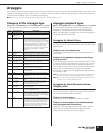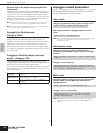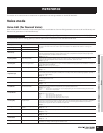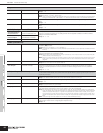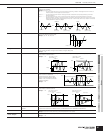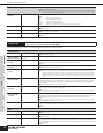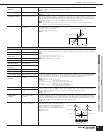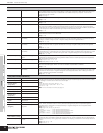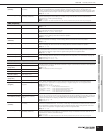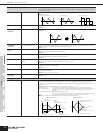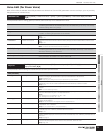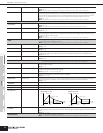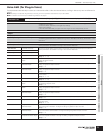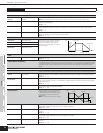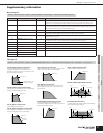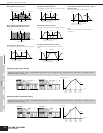
Owner’s Manual
Utility
Voice mode
Performance modeMulti modeEffectArpeggio
Reference
Voice mode Voice Edit (for Normal Voice)
71
FlwEGTmSns
(FlwSns)
FEG Time Key Follow
Sensitivity
Determines the degree to which the notes (specifically, their position or octave range) affect the Filter EG
times of the selected Element. The basic speed of change for the FEG is at the note specified in the
“CntrKy” (Center Key; see next parameter below). A positive setting will cause the amplitude of lower notes
to change slower and that of higher notes to change faster. A negative setting will have the opposite effect.
Settings: -64 ~ 0 ~ +63
FlwCntrKey (CntrKy)
FEG Time Key Follow
Sensitivity Center Key
Determines the central note for the “FlwSns” parameter above. When the Center Key note is played, the FEG
behaves according to its actual settings. The Filter change characteristics for other notes will vary in
proportion to the “TmVel” parameter settings.
Settings: C -2 ~ G8
n For details on the relationship between the EG Time Key Follow Sensitivity and the Center Key, see page 69.
AMP (Amplitude)
Level
Level Determines the output level for the selected Element.
Settings: 0 ~ 127
Pan
Pan Determines the stereo Pan position for the selected Element. This will also be used as the basic Pan position
for the Alternate, Random and Scale settings.
Settings: L63 (far left) ~ C (center) ~ R63 (far right)
AltnatePan (AltPan)
Alternate Pan Determines the amount by which the sound is panned alternately left and right for each received Note On
message. The Pan setting is used as the basic Pan position.
Settings: L64 ~ -0 ~ R63
RandomPan
(RdmPan)
Random Pan Determines the amount by which the sound of the selected Drum key is panned randomly left and right for
each received Note On message. The Pan setting (above) is used as the Center Pan position.
Settings: 0 ~ 127
ScalingPan (SclPan)
Scaling Pan Determines the amount by which the sound is panned alternately left and right for the Note Number of each
Note On message. At note C3, the main Pan setting (above) is used for the basic Pan position.
Settings: -64 ~ 0 ~ +63
LvlFlwSns (FlwSns)
Level Key Follow Sensitivity Determines the degree to which the notes (specifically, their position or octave range) affect the volume of
the selected Element. The level at C3 is used as the basic setting. A positive setting will lower the level for
lower notes and raise it for higher notes. A negative setting will have the opposite effect.
Settings: -200 ~ 0 ~ +200
ScaleBP1-4 (BP1-4)
Level Scaling Break Point Controls the Level above according to the Note Numbers. You can divide the entire keyboard by four break
points, and assign different offset values of amplitude to them respectively. For more details, see page 78.
Settings: BP (Break Point) 1-4: C-2 ~ G8
Settings: Ofst (Offset)1-4: -128 ~ 0 ~ +127
ScaleOfst1-4 (Ofst1-4)
Level Scaling Offset
AEG (Amplitude Envelope Generator)
AttackTime (AtkTm)
AEG Attack Time Makes all the time and level settings for the Amplitude EG, which determine how the volume of the sound
changes over time. These can be used to control the change in volume from the moment a note is played to
the moment the sound stops.
Settings: 0 ~ 127
n For details about the AEG, refer to page 57.
Decay1/2Time
(Dcy1/2Tm)
AEG Decay Time
ReleaseTime (RelTm)
AEG Release Time
InitLvl (InitLv)
AEG Initial Level
AttackLvl (AtkLv)
AEG Attack Level
Decay1/2Lvl
(Dcy1/2Lv)
AEG Decay Level
EGTmVelSns (TmVel)
AEG Time Velocity Sensitivity Determines the velocity sensitivity of the AEG’s Time parameters. First select the “Segmnt” (Segment), then
set its “TmVel” parameter. Positive “TmVel” parameter settings will play back the specified Segment
parameter faster in proportion to the played velocity. A negative setting will have the opposite effect.
Settings: TmVel: -64 ~ 0 ~ +63
Settings: Segmnt: atk, atk+dcy, dcy, atk+rls, all
atk (attack) ............................“TmVel” parameter affects Attack time.
atk+dcy (attack + decay)......“TmVel” parameter affects Attack/Decay1 time.
dcy (decay)...........................“TmVel” parameter affects Decay Time
atk+rls (attack + release)......“TmVel” parameter affects Attack/Release time.
all...........................................“TmVel” affects all AEG Time parameters.
SgmntVelSns
(Segmnt)
AEG Time Velocity Sensitivity
Segment
EGLvVelSns (LvlVel)
AEG Velocity Level Sensitivity Determines the velocity sensitivity of the Amplitude EG Level. For positive settings, the more strongly you
play the note, the more the volume changes. Negative settings do the opposite; the more softly you play, the
more the volume changes. The “CrvVel” parameter lets you select from five different preset velocity curves
(graphically indicated in the display), that determine how velocity affects the Amplitude EG.
Settings: LvlVel: -64 ~ 0 ~ +63
Settings: CrvVel: 0 ~ 4
CurvVelSns (CrvVel)
AEG Velocity Sensitivity
Curve
FlwEGTmSns
(FlwSns)
AEG Time Key Follow
Sensitivity
Determines the degree to which the notes (specifically, their position or octave range) affect the Amplitude
EG times of the selected Element. The “CntrKy” (Center Key, next parameter) is used as the basic amplitude
for this parameter. A positive setting will cause the amplitude of lower notes to change slower and that of
higher notes to change faster. A negative setting will have the opposite effect.
Settings: -64 ~ 0 ~ +63
FlwCntrKey (CntrKy)
AEG Time Key Follow
Sensitivity Center Key
Determines the central note for the “FlwSns” parameter above. When the Center Key is played, the AEG
behaves according to its actual settings. The amplitude change characteristics for other notes will vary in
proportion to the “FlwSns” parameter settings.
Settings: C-2 ~ G8
n For details on the relationship between the EG Time Key Follow Sensitivity and the Center Key, see page 69.



